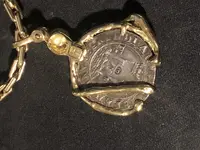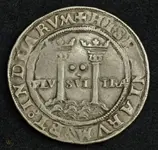Welcome to Tnet.
No way of knowing where this came from unless you can find the documentation that came with it, or can retrieve the auction record.
Nevertheless, it’s ‘Charles and Joanna’ coinage of Mexico City, which divides into “Early Series (1536-1542)” and “Late Series (1542-1571)” based on major design changes arising from the arrival of all-new dies from Spain. Yours is Late Series.
The L / oM on the left / right of the shield is for the assayer (Luis Rodriguez) / mint (Mexico City). Rodriguez assay then divides into two periods: c1547-c1553 and c1554-1569, with the later period having a cruder style of engraving and generally struck on planchets with more variable thickness and roundness. Yours looks to be from that later period (consistent with the style of the design).
Spread across the pillars you have the ‘PLVS VLTRA’ inscription (variously abbreviated on these coins as PLVSVLT, PLVSVL, PLVSVT or LVSV) and above it a single ‘dot'. That indicates it’s a ‘one real’ (the ‘two reales’ would have two dots side by side, and different indications were used for other denominations).








